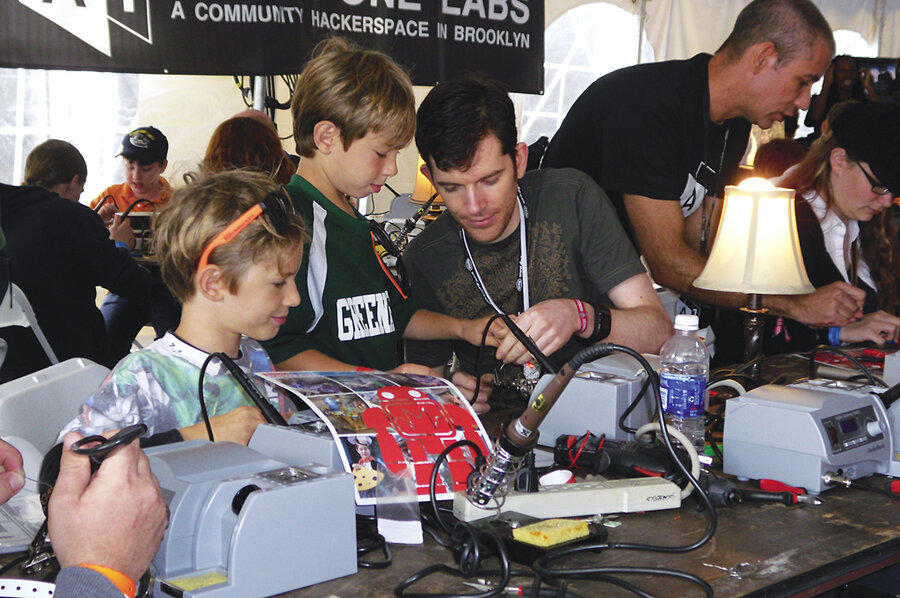Maker Faire: Mad science for the masses
Loading...
| New York
To the uninitiated, the scene at the New York Hall of Science in Queens, N.Y., might look like a bus load of engineering students staging a carnival. A car drives around outside covered in mechanical fish singing "Bohemian Rhapsody." Under one pavilion, kids get a first taste of how to solder electronics, while inside the main building, a group called ArcAttack makes music with half-million-volt Tesla coils.
In short, it's Maker Faire, a three-day event in September that brings artists, engineers, crafters, and mad scientists together to share their joy of creating. And increasingly, it's kids who are doing the mad science.
Among them stands 14-year-old Joe Hudy, a self-professed "maker," with a massive pneumatic marshmallow cannon to prove it. He's been constructing his own fun for as long as he can remember, and the reason is simple, Joe says: "People just love to build things."
David Giancaspro, a writer for Wired magazine's GeekDad website, believes that people – adults and kids alike – have a natural urge to want to build things. "As we've moved further and further away from that, towards what people call 'knowledge work,' as opposed to producing something physical, that urge is starting to come back," he says.
For Joe, Mr. Giancaspro, and other makers, this primal urge struck at a wonderful time. Lots of once-expensive electronics have now become low-cost toys for tinkerers. For example, Giancaspro points to the Arduino single-board microcontroller. The board, available for around $30, allows budding inventors to embed computer controls into anything from homemade robots to color-changing origami lanterns like the ones the Wired writer designed himself.
"The Arduino really lowered the bar of how much you needed to know just to get some interesting electronics going," he says.
Recently, inexpensive 3-D "printers" have also made creating things more accessible. These devices generate physical objects, such as small figurines or parts, by squirting out plastic or resin to build up objects layer by layer, all according to a computer model.
As more makers spread their wings, corporate America is starting to take notice.
RadioShack used to be a local hangout for young electronics geeks looking for parts or advice, but in recent years the company has pushed away from do-it-yourself projects and toward consumer electronics. Now, RadioShack has signaled a move back toward the DIY community, releasing a survey to ask makers what parts they'd like to see for sale. And this fall, all RadioShack stores will start stocking Arduino hardware, according to Amy Shineman, the retailer's director of consumer and product marketing.
"We miss having the consumer group in our stores," she says. "We feel like they're an audience that is being underserved."
Computer-design giant Autodesk has long supported programs such as the annual student competition FIRST Robotics, but this year they took the unexpected step of acquiring Instructables, a website devoted to DIY enthusiasts, particularly young ones.
"Our CEO is a giant maker, along with a lot of our upper staff," says Jesse Harrington Au, Autodesk's official "maker advocate." The company hopes to introduce Instructables to a broader audience.
The website's founder, Eric Wilhelm, says his readers share a need for individual expression. "They want to learn how to make physical objects and customize things in the way that they can easily personalize things in the digital world," he says. To him, the benefit of working with your hands is obvious: "Engagement. Just being engaged with your world leads to all sorts of positive outcomes."
Back home in Phoenix, Joe heads out once a week to the local "Hackerspace" in nearby Mesa, Ariz. These communal sites have popped up all over the country, offering makers the chance to meet, collaborate, and use more advanced equipment, such as 3-D printers and laser cutters.
With his marshmallow cannon complete, Joe has bigger projects in his sights. He'd like to build an electric car, but that will require more money and new skills, such as welding.
Across the fairground, a group called the Brooklyn Aerodrome demonstrates its radio-controlled airplanes built using trash. Luca Vermeer, 13, caught the builder bug at last year's Maker Faire, and is now a member of the Brooklyn group.
Like many young makers, Luca is not the first in her family to show an interest. She says that her parents have always been working on projects. And unlike previous generations, where "geek" proclivities isolated kids from peers, the current batch of makers is surprisingly social.
"If you look in the right places, it's pretty easy to find other people who like to do stuff like this," says Luca. "Here, it's really easy because everyone [does]. But if you go online, you can find different websites, different people who are into it."
To many, the father of the maker movement is Dale Dougherty, one of the founders of Make Magazine and creator of Maker Faire, which now runs yearly in the San Francisco Bay Area, Detroit, New York, and occasionally in other cities. While the movement started among adults, Mr. Dougherty says it's perhaps more important for kids to join their ranks.
"Today, many kids have lots of choices and their lives are very structured; other kids are disadvantaged by the community and resources available to them," writes Dougherty in an e-mail. "We'd like to see each of them have the opportunity to explore their own interests and develop a sense that they are directing their own learning and their own future."
President Obama has made an increased emphasis on the so-called STEM subjects (science, technology, engineering, and math) a cornerstone of his education program. But walking around the fair, you'd be hard-pressed to believe there is a shortage of kids interested in the subject.
For Wired's Giancaspro, the maker movement is a natural partner to STEM education. "I call it recreational engineering," he says. "It's helping kids see that there are things you can do, that there are futures in this kind of industry."





